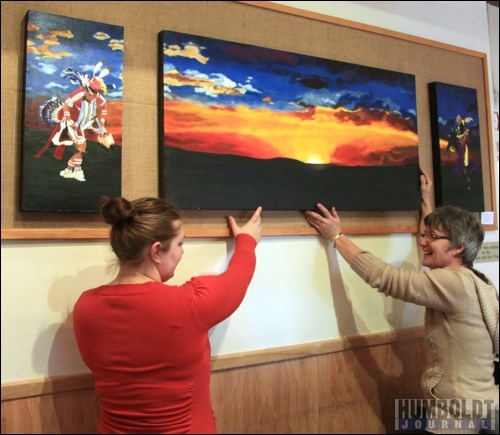The new exhibit entitled "What We Do," adorning the walls of the Humboldt Museum is an example of how at-risk youth can overcome the odds using art as a medium.
"There is a bio card accompanying each piece that tells the public what the artist is doing now," said Anneka Drinkwater, programmer at the Humboldt and District Museum and Gallery.
The display contains a variety of subjects and a range of mediums. From pencil sketches to mixed media work, the pieces are designed to showcase the diversity of the artists' talents.
"About a year ago, we were looking at different places outside of Saskatoon to show our work," said Jordan Schwab, arts and personal development coordinator for the Saskatoon Community Youth Arts Programming Humboldt was one of the places willing to show it and it worked out really well for us, since it is only an hour away."
Saskatoon Community Youth Arts Programming (SCYAP) is a not-for-profit organization established in 2001 to offer visual and graphic arts training. The feature program, the Urban Canvas Project, successfully graduated students for 10 years before funding was discontinued.
"Each year, we would start with between 12 and 14 students and on average seven to eight students would graduate," noted Schwab. "Our most successful year was 2012 when 11 of the 12 students graduated."
Prior to 2004, SCYAP was not in its present location, so very little artwork from the early years of the program is in the organization's permanent collection. Pieces from 2004 to 2011 are included in the exhibit.
The Urban Canvas Project was dedicated to the instruction of art. As Schwab explained, the program ran five days a week and students spent seven hours per day in the studio.
"Unlike other places where art students may get 35 hours of studio in an entire semester, our students were getting that per week," said Schwab. "We broke the day up with other life skills sessions but for the most part, the students were in the studio learning and working."
Because of the number of hours spent in the studio, the students learned they could do art, no matter what level they entered at and it was a very subtle way of instilling a sense of discipline into other aspects of their lives, noted Schwab.
The success of the program is shown by the "where are they now" section on each of the bio cards. Some of the graduates are now working with SCYAP.
Also included in the display at the museum are some of the educational comics from the Street Graphix program.
"We began working with the Saskatoon Health Region in 2010 on creating an HIV awareness program," said Schwab.
The comics are based on real-life youth stories. Graduates of the Urban Canvas Project drew the comics and now the program is working on having youth going into the schools and sharing the interactive cartoons.
"It is essentially a program by the youth for the youth," said Schwab.
While the Urban Canvas project is currently on hold because of a lack of funding, SCYAP does offer a number of other smaller programs and opportunities for youth, of which one is a drop-in centre.
"The exhibit is an opportunity to advertise for us," Schwab said. "Our drop-in centre is a place where like-minded people can gather and gain support from one another. It is also a place, newcomers to the city, can use as a base."




